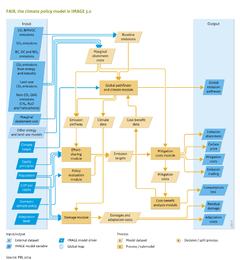Climate policy/Description: Difference between revisions
Jump to navigation
Jump to search
No edit summary |
No edit summary |
||
| Line 32: | Line 32: | ||
===Damage and cost-benefit module=== | ===Damage and cost-benefit module=== | ||
The damage and cost-benefit module calculates the consumption loss resulting from the damage of climate change, and compares these with the consumption losses of adaptation and mitigation costs (for instance, [[Hof et al., 2008]]; [[Hof et al., 2009]]; [[Hof et al., 2010]]). The estimates on adaptation costs and residual damage were based on the [[AD-RICE model]] ([[De Bruin et al., 2009]]). The AD-RICE model estimates adaptation costs based on total damage projections by the RICE model. These total damage projections include both adaptation costs and residual damage. Calibration of the regional adaptation cost functions was based on an assessment of each impact category described in the RICE model, using relevant literature, supplemented with expert judgement where necessary. The optimal level of adaptation can be calculated by the model, but the level of adaptation may also be set to a non-optimal level by the user. Consumption losses are estimated based on a simple Cobb-Douglas economic growth model. First, this model, for each region, is separately calibrated to the exogenous GDP path. Next, damage, adaptation costs and abatement costs are subtracted from investment or consumption to determine the effect on consumption (directly by replacing consumption or indirectly by replacing investments). | The damage and cost-benefit module calculates the consumption loss resulting from the damage of climate change, and compares these with the consumption losses of adaptation and mitigation costs (for instance, [[Hof et al., 2008]]; [[Hof et al., 2009]]; [[Hof et al., 2010]]). The estimates on adaptation costs and residual damage were based on the [[AD-RICE model]] ([[De Bruin et al., 2009]]). The AD-RICE model estimates adaptation costs based on total damage projections by the [[RICE model]]. These total damage projections include both adaptation costs and residual damage. Calibration of the regional adaptation cost functions was based on an assessment of each impact category described in the RICE model, using relevant literature, supplemented with expert judgement where necessary. The optimal level of adaptation can be calculated by the model, but the level of adaptation may also be set to a non-optimal level by the user. Consumption losses are estimated based on a simple Cobb-Douglas economic growth model. First, this model, for each region, is separately calibrated to the exogenous GDP path. Next, damage, adaptation costs and abatement costs are subtracted from investment or consumption to determine the effect on consumption (directly by replacing consumption or indirectly by replacing investments). | ||
}} | }} | ||
Revision as of 13:43, 17 December 2013
Parts of Climate policy/Description
| Component is implemented in: |
|
| Related IMAGE components |
| Models/Databases |
| Key publications |
| References |
|
